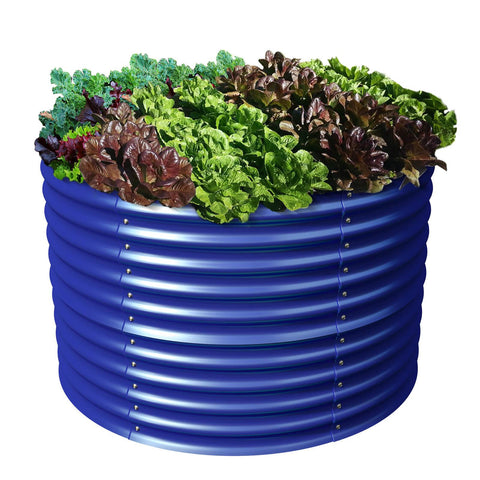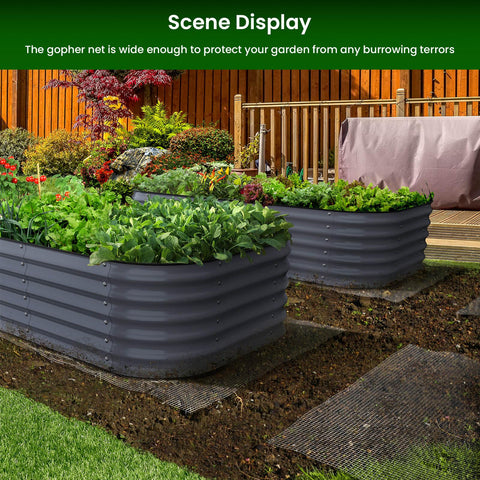How to Plant Lettuce in Garden Beds
For the impatient gardeners waiting for the last spring frost, planting lettuce can relieve their tension. Its fresh, vibrant leaves will soon rise, making it a popular sight in the first few weeks of spring. Leaf lettuce is a variety that does not produce any type of head. They are easier to grow than other varieties, including long leaf lettuce, buttered head and crispy head, and can be harvested many times throughout the season. So prepare your garden beds and start sowing lettuce! Home grown lettuce is also more nutritious and delicious than anything you find in the grocery store.
Fresh harvested crisp leaves are rich in vitamin A and potassium. Trying different varieties will open your palate to the new taste of green leafy vegetables that you never knew existed.
Not to mention, few garden tasks are more satisfying than assembling freshly harvested salads.
Individual plants require little space and basic maintenance. Once the leaves reach the available size, you can harvest them as needed.

Lettuce is available in a variety of varieties and colors, making your garden and table full of vitality.
Be careful to prepare the garden bed
Spending more time preparing your garden bed will have a significant impact on your harvest.
Most leaf lettuce can be grown in early spring, as long as the soil can work. Therefore, it is better to prepare the garden bed as soon as possible.
Ideally, the soil should be loam, well drained, and rich in organic matter, which helps to maintain soil moisture. The optimum soil pH value for lettuce is 5.8 to 6.5.
The seeds are very small. In the soil without big lumps, you will have better germination rate.
Plants also grow rapidly, are small in size and have shallow roots. As a result, they are more susceptible to water related pressures and less active in the presence of weeds.
Old seedbed cultivation is an effective method to reduce weed seeds.
Prepare the soil a few weeks before planting garden crops. Once weeds begin to appear, gently cultivate the soil to eradicate weeds, but not too heavy, so as to avoid bringing new weed seeds to the soil surface and having a chance to germinate. This method greatly reduces the presence of weeds.
Sow, Water, Repeat
The key to delicious and tender leaves is to keep the seedlings fresh. To do this, sow in turn.
Start a batch of seeds indoors six weeks before the average spring frost date of last year or eight weeks before the first average frost date of autumn in your area.
Don't forget to harden the seedlings before transplanting them into the garden.
Once the soil is available, plant another batch of seeds directly in the sunny garden. Germination is expected to occur within 7 to 10 days.
Since lettuce seeds are very small, it will be a challenge not to sow too much. Once the seedlings are several inches tall, thin them to about 4 to 8 inches depending on the variety.
A few weeks later, sow another batch directly. Cover the seeds with 1/2 inch of soil and keep them moist, but do not soak them.
In general, the idea is to plant multiple rows or groups of lettuce every two weeks throughout the growing season. This will ensure a continuous supply of seedlings for optimum harvest.

Older plants shed more easily, and they usually grow bitter, tough leaves.
Don't hesitate to harvest the whole plant before they pass the harvest peak. This should be done before they mature, usually within 60 days.
Diseases and pests to be understood
Watch out for aphids, which hide at the bottom of the leaves.
Although the population of aphids can grow rapidly and seems to come from nowhere, aphids can be easily controlled by the firm and frequent explosion of hoses.
Planting onions or chives in lettuce is another good choice to prevent pests such as aphids.
The black silkworm is sneaky and causes damage at night. If you notice that the seedlings are pruned off at the bottom of the plant, these small animals may be the culprits.
Diatomaceous earth or finely ground eggshells scattered around plants can take care of slugs and other soft bodied pests, such as slugs.
Rabbits, squirrels and deer also like to chew young lettuce leaves. Fences or covers are the best line of defense against these more obvious offenders.
If you notice that the tip of the leaf starts to look scorched, the plant may be affected by the tip burn.
This physiological condition is usually the result of inconsistent water content, especially during drought. This may also indicate that the soil pH is incorrect.
Remember to keep watering. If you want your crops to grow well, please pay attention to the weather.
Make full use of lettuce
All lettuce are considered cool seasonal crops and perform best in the temperature range of 50 to 70 ° F. Once the temperature reaches 80 ° F and the night becomes warm, the plants will bloom and begin to bloom.
However, in many regions, several long-acting varieties can be produced throughout the growing season. Similarly, some varieties are more tolerant of frost than others.
Choosing the right variety for your region and season is the key to making full use of plants.
If your goal is to plant leafy lettuce throughout the summer, choose a heat-resistant variety. In addition, lettuce is intercropped with tall summer crops such as pepper, corn and tomatoes to provide additional shade.
Adequate watering is particularly important for high-yield crops. Shallow roots make plants vulnerable to water related pressures, so water often and at least 6 inches deep.
Don't use heavy hands when watering, because too much water will promote disease. If possible, water in the morning, so that the plants have a chance to dry in the day.
A layer of organic mulch will help maintain soil moisture, protect roots and prevent weeds.
The practice of extending the season applies to leaf lettuce. Row covers and cold frames allow you to plant them earlier in the spring, or even throughout the winter in some areas.
Row covers can also be used well in hot summer to provide shade and delayed bolting. Not to mention, plants can be planted under the cover of the whole growing season to prevent many pests from reaching them before you do so.
Leaf lettuce is also an excellent choice for growing in containers. Keep in mind that you probably need to water the container plants more frequently.

Can I help you?
For delicious salad, I prefer to plant various seeds. Depending on how much space you have, combined with continuous planting, once your seedlings take off, this will result in an almost constant harvest. Here are some of our favorite leaf types for you to choose from:
"Lollo Rosso" lettuce (Lactuca sativa 'llorossa') is an Italian variety with wrinkled leaves, dark pink leaves and green bottom. Sometimes it is spelled as female, namely "LollaRossa", and you can choose your favorite name.
This type performs well in cooler areas and is very suitable for beginners because it is famous for being slow to rough. Seeds can be purchased from the real leaf market.
Classic green salad lettuce, "Grand Rapids" is a good choice if you are looking for something more traditional. This frill leaf type is resistant to tip burns, crisp, tender and smooth.
Well, we'll give you a guess why this variety is called "oak leaf". This type has matured in just 40 days. Utah State University supports this option, so it must be very good.
You will like the light green, tender leaves.
Another popular "black seed Simpson" among beginners is easy to grow and can tolerate some sunshine.
Easy to grow and eat
Be sure to do something well, and you will soon enjoy fresh garden salad.
Well prepared, weed free, well drained soil rich in organic matter will ensure plant health. The continuously moist soil makes lettuce grow quickly and happily. Continuous planting can provide you with tender leaves within reach throughout the season.
You won't be disappointed if you choose the right variety according to your needs.
Are you excited about planting lettuce this year?
